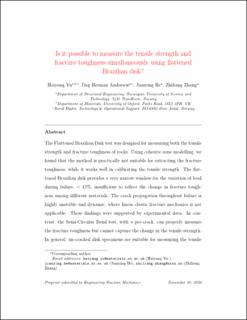| dc.contributor.author | Yu, Haiyang | |
| dc.contributor.author | Andersen, Dag Herman | |
| dc.contributor.author | He, Jianying | |
| dc.contributor.author | Zhang, Zhiliang | |
| dc.date.accessioned | 2021-03-23T11:50:39Z | |
| dc.date.available | 2021-03-23T11:50:39Z | |
| dc.date.created | 2021-02-26T11:21:42Z | |
| dc.date.issued | 2021 | |
| dc.identifier.issn | 0013-7944 | |
| dc.identifier.uri | https://hdl.handle.net/11250/2735087 | |
| dc.description.abstract | The Flattened Brazilian Disk test was designed for measuring both the tensile strength and fracture toughness of rocks. Using cohesive zone modelling, we found that the method is practically not suitable for extracting the fracture toughness, while it works well in calibrating the tensile strength. The flattened Brazilian disk provides a very narrow window for the variation of load during failure, < 15%, insufficient to reflect the change in fracture toughness among different materials. The crack propagation throughout failure is highly unstable and dynamic, where linear elastic fracture mechanics is not applicable. These findings were supported by experimental data. In contrast, the Semi-Circular Bend test, with a pre-crack, can properly measure the fracture toughness but cannot capture the change in the tensile strength. In general, un-cracked disk specimens are suitable for measuring the tensile strength and pre-cracked specimens for the fracture toughness. It is very challenging, if not impossible, to measure both with a single test. It is further implied that the first peak on the loading curve in such kind of tests is trustworthy for extracting mechanical properties, while the following second turning point (if existing) is unreliable as it may contain dynamic effect. These results provide useful reference for the selection and design of test methods using Brazilian disk related geometries. | en_US |
| dc.language.iso | eng | en_US |
| dc.publisher | Elsevier | en_US |
| dc.rights | Attribution-NonCommercial-NoDerivatives 4.0 Internasjonal | * |
| dc.rights.uri | http://creativecommons.org/licenses/by-nc-nd/4.0/deed.no | * |
| dc.title | Is it possible to measure the tensile strength and fracture toughness simultaneously using flattened Brazilian disk? | en_US |
| dc.type | Peer reviewed | en_US |
| dc.type | Journal article | en_US |
| dc.description.version | acceptedVersion | en_US |
| dc.source.journal | Engineering Fracture Mechanics | en_US |
| dc.identifier.doi | https://doi.org/10.1016/j.engfracmech.2021.107633 | |
| dc.identifier.cristin | 1893997 | |
| dc.description.localcode | "© 2020. This is the authors’ accepted and refereed manuscript to the article. Locked until 6.3.2023 due to copyright restrictions. This manuscript version is made available under the CC-BY-NC-ND 4.0 license http://creativecommons.org/licenses/by-nc-nd/4.0/ " | en_US |
| cristin.ispublished | false | |
| cristin.fulltext | postprint | |
| cristin.qualitycode | 1 | |

